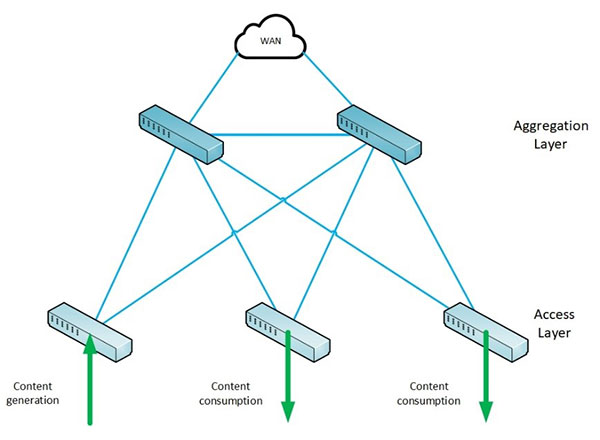As the world moves toward unified IP networks, selecting hardware that meets the strict requirements of the unified IP networks and network design become more important. Why? Different traffic types often have opposite requirements. For example, data traffic can typically tolerate some delay as long as the data itself conceded no errors during transmission. On the other hand, live traffic (voice calls, videoconferences) is exactly the opposite, as errors and packet losses will result in a subsecond glitch that is hardly distinguishable, but latency and jitter will prevent a user from conducting a conversation.
Moreover, IP networks have matured enough in recent years in both reliability and throughput to handle one of the most demanding applications: high and ultra-high definition audio/video (AV) systems, which bring another layer of complexity to the equation with their requirements:

The Spine-and-Leaf topology
Latency, error rate, and throughput performance requirements create a new paradigm for designing IP networks where no oversubscription is possible, as each video source uses its entire access bandwidth 24x7x365. One of the most popular network designs that meets the strict demands of high-quality AV is the cost-effective Spine-and-Leaf topology that eliminates single points of failure. Here is some key information on Spine-and-Leaf topology:
Not sure what type of network you need to support your application? Contact Black Box. We have a wide variety of proven networking hardware, as well as years of experience designing and deploying AV distribution and video wall solutions of any size and complexity. We are truly a one-stop shop for all of your AV and KVM projects.

Solutions Architect
Max has a broad range of experience in IP technologies and related fields. Before Black Box, he worked as a Network Engineer and as a Field Application Engineer. In his current role as a Solutions Architect, his primary focus is designing and deploying large AV and KVM systems with complex network components. Max holds two M.S. degrees in telecommunications and networking. He got his first degree from the National Technical University of Ukraine (KPI) and the second from the University of Pittsburgh.